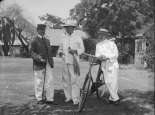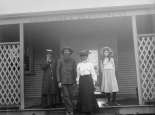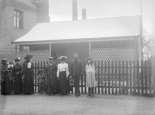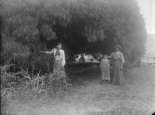Impacts of Law Post 1905
Arguably, the Aborigines 1905 Act (WA) has had the most significant impact on Noongar people, an impact that lasted well into the 1960s and 70s. People such as William Harris, who led a deputation to Premier Collier in 1928, resisted the oppression of this legislative and administrative regime under the control of a Chief Protector.
Aborigines Act 1905 (WA)
An Act to make provision for the better protection and care of the Aboriginal inhabitants of Western Australia
The purpose of the Aborigines Act (continued from the earlier 1886 Act) was the ‘protection, control and segregation of Aboriginal people’. Unlike the earlier legislation, the impact of the 1905 Act was far-reaching, establishing an administrative regime under the control of a Chief Protector that invaded every aspect of Noongar people’s lives.[i] The Act assumed that Aboriginal people were a ‘dying race’ in its objective of forced assimilation of future generations.
The Act incorporated terms of ‘caste’ and ‘blood’ into the definition of ‘Aboriginality’ where ‘persons deemed to be Aborigines include all Aboriginal inhabitants of Australia, and half-castes or their children’. More Noongar people were affected by this Act than any previous discriminatory legislation, and its impact lasted well into the 1970s (reinforced by subsequent amending Acts) [ii]
The Chief Protector had wide-reaching power as legal guardian of all Aboriginal children (under 16 years) whom he decided were illegitimate. He could grant or deny permission for Aboriginal women to marry non-Aboriginal men and could manage the property of Aboriginal people without their consent.[iii] Freedom of movement was also restricted. In the subsequent 1936 Native Administration Act, which continued the objectives of the 1905 Act, there were severe penalties, including imprisonment for cohabitation between Noongars and Europeans. Police had extensive powers of surveillance, which continued for some time.
The segregation reinforced by the Act and the existing attitudes based on race, established an apartheid regime where Aboriginal people in Western Australia were discriminated against in all sorts of ways. Civil rights were denied by the Act. For example: those Noongars who had lost control of their property under the 1905 Act lost their eligibility to vote at State Elections.
In 1893, men were entitled to vote at WA elections if they leased or owned property. The Commonwealth Franchise Act, 1902, stated that no ‘Aboriginal native of Australia, Asia or Africa’ were entitled to vote unless already enrolled as voters in their State. Even if Noongars were eligible to vote, this right was removed by the Electoral Act 1907. (See List of WA Legislation.) Aboriginal people did not obtain the right to vote at State and Federal elections until 1962.[iv]
Exemption certificate
The Chief Protector had power to grant exemption from the Act. In order to obtain exemption from the application of the Act, Aboriginal people had to apply for a certificate of exemption, which meant they were eligible for rights that belonged to other Australians.
Example of an exemption recommendation
An example of an certificate of exemption granted on 25 March, 1912
Missions and Reserves
The Governor had discretion to declare Aboriginal reserves and to remove Noongar families to those reserves. These included Carrolup near Katanning and the Moore River Native Settlement.
Towns
Noongar people also had to have a permit to work and to live in town. The Governor had discretion to declare any place a prohibited area for Aboriginal people. Noongars were subsequently not allowed to spend time in towns and were restricted from certain places.
Perth
The prohibitions applied not only to rural towns but to Perth. On 18th March, 1927, the Governor of Western Australia relied on the 1905 Act to declare the City of Perth a prohibited area for Aboriginal people. This particularly affected Noongar people who lived and worked there.
Noongars could not loiter in towns. They had to be there on particular business and were required to have a pass for work and entering a town. In Perth, there was a six o’clock curfew which made it illegal for Aboriginal people to be in town.
The reach of the Act extended to segregation in the area of education. ‘There was little interest in educating Noongar children’.[v] The Department of Education opposed the enrolment of Aboriginal children in state schools.[vi]
Despite this, several Noongar resisted the imposed regime. Edward and William Harris were part of a delegation [vii] who fought the effects of the 1905 Act and advocated for Aboriginal people to be given basic civil rights like other Australians. This included the right to education in state schools (not just token education).
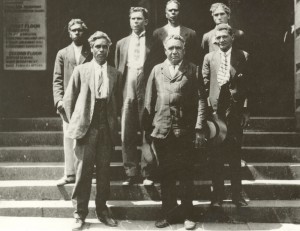
Deputation to the Premier 1928. Back row (left to right): Wilfred Morrison, Norman Harris, Edward Jacobs, A. Kickett and William Bodney. Front (left to right): Edward Harris and William Harris. Courtesy of Corrie Bodney and Claremont Museum, 07.99
Subsequent legislation of 1936 and 1944 caught more Aboriginal people within its control and maintained the requirement for certificates of citizenship.[viii] The Native Administration Act, 1936 created a classification of ‘quadroon’, where those legally defined as having one quarter blood came under the Act. However, they were not subject to the legislation if they were under 21 years and ‘did not associate and live in the manner of natives’. That said, a ‘non-native’ could be classified as ‘native’ by a magistrate.[ix]
A certificate of citizenship had to be obtained in order to get work. Noongar people were subsequently forced to renounce their identity to become an Australian citizen. You could not be a Noongar person and an Australian citizen at the same time. It meant that some members in families were classed as citizens and had the same rights as European citizens, whilst others did not. This created tensions within Noongar families.
In 1947, the Coolbaroo League (Noongar word: Kulbardi) was established. As well as being a club for social events and dancing for both Indigenous people and Europeans, it also fought to remove the prohibition area in Perth. The prohibited area was eventually removed in 1954.[x]
A lasting effect of the 1905 legislation was that Noongar people continued to be wary of police and avoided contact with them.
While the impact of the Act was to deny Noongars our rights to practice our language and culture at work, school and other places, Noongar people continued to struggle for our rights. This included a quality western education, whilst retaining our Noongar language, culture and knowledge for present and future generations. Something which today is still regarded as important for the future of Noongar families and communities.
The fact that children aged 16 years (or from 1936, 21 years) came under the control of the Chief Protector meant that they could be removed from their families and placed in institutions or adopted out. (See Stolen Generations)
Joe Northover talks about citizenship papers Part I
Joe Northover talks about citizenship papers Part II
References
[i] Proclaimed in April, 1906
[ii] J Host with C Owen, It’s still in my heart, This is my country: The Single Noongar Claim History, UWAP, Nedlands, 2009
[iii] In 1936 this was 21 years.
[iv] Australian Electoral Commission website (Cth) http://www.aec.gov.au/Voting/indigenous_vote/indigenous.htm (accessed 10 November 2010)
[v] A Haebich, For their own Good, UWA Press, Nedlands, 1988, p.82
[vi] A Haebich, For their own Good, UWA Press, Nedlands, 1988, p.260
[vii] William Harris, Australian Dictionary of Biography, http://abdonline.anu.edu.au/biogs/A090213b.htm(accessed 30 October 2010); S Delmege, A Trans-Generational Effect of the Aborigines Act 1905 (WA): The Making of the Fringedwellers in the South West of Western Australia, E Law- Murdoch University Electronic Journal of Law, Vol 12 No 1 and 2. http://www.murdoch.edu.au/elaw/Issues/v12n1_2/Delmege12_1.html (accessed 3 October 2010)
[viii] Native Administration Act 1936(W.A) and Native (Citizenship Rights) Act, 1944 (W.A.)
[ix] Chris Owen, Paper on 1905 and 1936 Acts.
[x] Jo Darbyshire, The Coolbaroo Club 1947-1960 An Exhibition exploring the contemporary history of Aboriginal people in the city of Perth and celebrating the role of the Coolbaroo League in this decade of change after the Second World War. 2010
